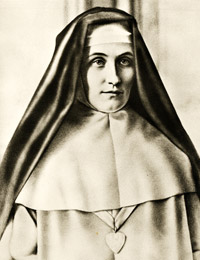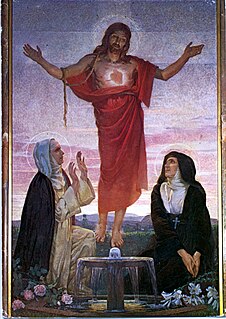
The devotion to the Sacred Heart is one of the most widely practised and well-known Catholic devotions, wherein the heart of Jesus is viewed as a symbol of "God's boundless and passionate love for mankind". This devotion is predominantly used in the Catholic Church, followed by high-church Anglicans, Lutherans and some Western Rite Orthodox. In the Latin Church, the liturgical Solemnity of the Most Sacred Heart of Jesus is celebrated the third Friday after Pentecost. The 12 promises of the Most Sacred Heart of Jesus are also extremely popular.
The First Saturdays Devotion, also called the Act of Reparation to the Immaculate Heart of the Blessed Virgin Mary, is a Catholic devotion which, according to Sister Lúcia of Fátima, was requested by the Virgin Mary in an apparition at Pontevedra, Spain, in December 1925. This devotion has been approved by the Roman Catholic Church.

The Solemnity of the Most Sacred Heart of Jesus is a solemnity in the liturgical calendar of the Roman Rite of the Catholic Church and certain Anglo-Catholic communities. As celebrated in the Roman Rite of the Latin Church, it falls on the Friday that follows the second Sunday after Pentecost.

Margaret Mary Alacoque, was a French Roman Catholic Visitation nun and mystic, who promoted devotion to the Sacred Heart of Jesus in its modern form.

Divine Mercy Sunday is celebrated on the Second Sunday of Easter, which concludes the Octave of Easter. The feast day is observed by Roman Catholics as well as some Anglo-Catholics of the Church of England. It is originally based on the Catholic devotion to the Divine Mercy that Faustina Kowalska reported as part of her encounter with Jesus, and is associated with special promises from Jesus and indulgences issued by the Catholic Church.
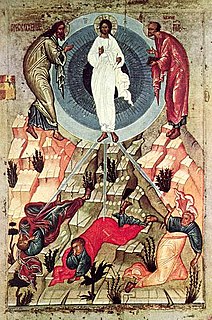
The Image of the Divine Mercy is a depiction of Jesus Christ that is based on the devotion initiated by Faustina Kowalska.

The Chaplet of the Divine Mercy, also called the Divine Mercy Chaplet, is a Christian devotion to the Divine Mercy, based on the Christological apparitions of Jesus reported by Faustina Kowalska (1905–1938), known as "the Apostle of Mercy." She was a Polish religious sister of the Congregation of the Sisters of Our Lady of Mercy and canonized as a Catholic saint in 2000.
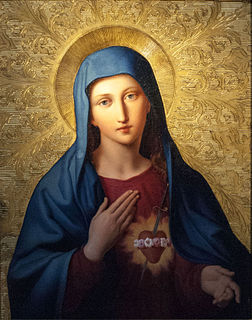
The Immaculate Heart of Mary is a Roman Catholic devotional name used to refer to the Catholic view of the interior life of Mary, mother of Jesus, her joys and sorrows, her virtues and hidden perfections, and, above all, her virginal love for God the Father, her maternal love for her son Jesus Christ, and her motherly and compassionate love for all mankind. Traditionally, the Immaculate heart is depicted pierced with seven wounds or swords, in homage to the seven dolors of Mary and roses, usually red or white, wrapped around the heart.
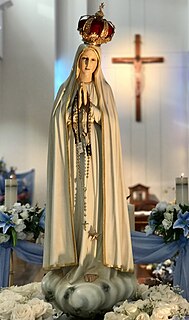
The Blue Army of Our Lady of Fátima, now mostly known as the World Apostolate of Fátima, is a public international association of the Christian faithful that has as its general purpose "the promotion of the authentic teaching of the Roman Catholic Church and the strict adherence to the tenets of the Gospel; the personal sanctification of adherents through faithful adherence to the Message of Our Lady of Fátima and the promotion of the common good by the spreading of that Message of Fátima".

Eucharist here refers to Holy Communion or the Body and Blood of Christ, which is consumed during the Catholic Mass or Eucharistic Celebration. "At the Last Supper, on the night he was betrayed, our Savior instituted the Eucharistic sacrifice of his Body and Blood, ... a memorial of his death and resurrection: a sacrament of love, a sign of unity, a bond of charity, a Paschal banquet 'in which Christ is consumed, the mind is filled with grace, and a pledge of future glory is given to us.'" As such, Eucharist is "an action of thanksgiving to God" derived from "the Jewish blessings that proclaim – especially during a meal – God's works: creation, redemption, and sanctification."

Catholic devotions are particular customs, rituals, and practices of worship of God or honour of the saints which are in addition to the liturgy of the Catholic Church. The United States Conference of Catholic Bishops describes devotions as "expressions of love and fidelity that arise from the intersection of one's own faith, culture and the Gospel of Jesus Christ". Devotions are not considered part of liturgical worship, even if they are performed in a church or led by a priest, but rather they are paraliturgical. The Congregation for Divine Worship at the Vatican publishes a Directory on Popular Piety and the Liturgy.
Pure Heart is a term used by many different spiritual beliefs.
A tradition held by the Order of Preachers holds that through Saint Dominic and Alan de Rupe, the Blessed Virgin Mary made fifteen specific promises to Christians who faithfully pray the Rosary. The fifteen stated promises range from protection from misfortune to meriting a high degree of glory in heaven.
Reparation is a theological concept closely connected with those of atonement and satisfaction. In ascetical theology, reparation is the making of amends for insults given to God through sin, either one's own or another's. The response of man is to be reparation through adoration, prayer, and sacrifice. In Roman Catholic tradition, an act of reparation is a prayer or devotion with the intent to expiate the "sins of others", e.g. for the repair of the sin of blasphemy, the sufferings of Jesus Christ or as Acts of Reparation to the Virgin Mary.
In the liturgy of the Catholic Church, a votive Mass is a Mass offered for a votum, a special intention.
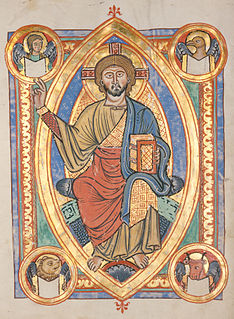
The Roman Catholic tradition includes a number of devotions to Jesus Christ. Like all Catholic devotions, these prayer forms are not part of the official public liturgy of the Church but are based on the popular spiritual practices of Roman Catholics. Many are officially approved by the Holy See as suitable for spiritual growth but not necessary for salvation.

A number of prayers to Jesus Christ exist within the Roman Catholic tradition. These prayers have diverse origins and forms. Some were attributed to visions of saints, others were handed down by tradition.

The Act of Consecration to the Sacred Heart of Jesus are two Roman Catholic prayers, one composed by Saint Margaret Mary Alacoque and the other composed by Blessed Mary of the Divine Heart. It was a part of the private revelations reported by the two mystical nuns regarding the Sacred Heart of Jesus.

The Alliance of the Hearts of Jesus and Mary refers to the historical, theological and spiritual links in Catholic devotions to the Sacred Heart of Jesus and the Immaculate Heart of Mary.

Our Lady of Pellevoisin is a title of the Blessed Virgin Mary which refers to a series of Marian apparitions in Pellevoisin, in the province of Berry, in the department of Indre, France. Pellevoisin is west of Châteauroux in the Catholic Archdiocese of Bourges.

